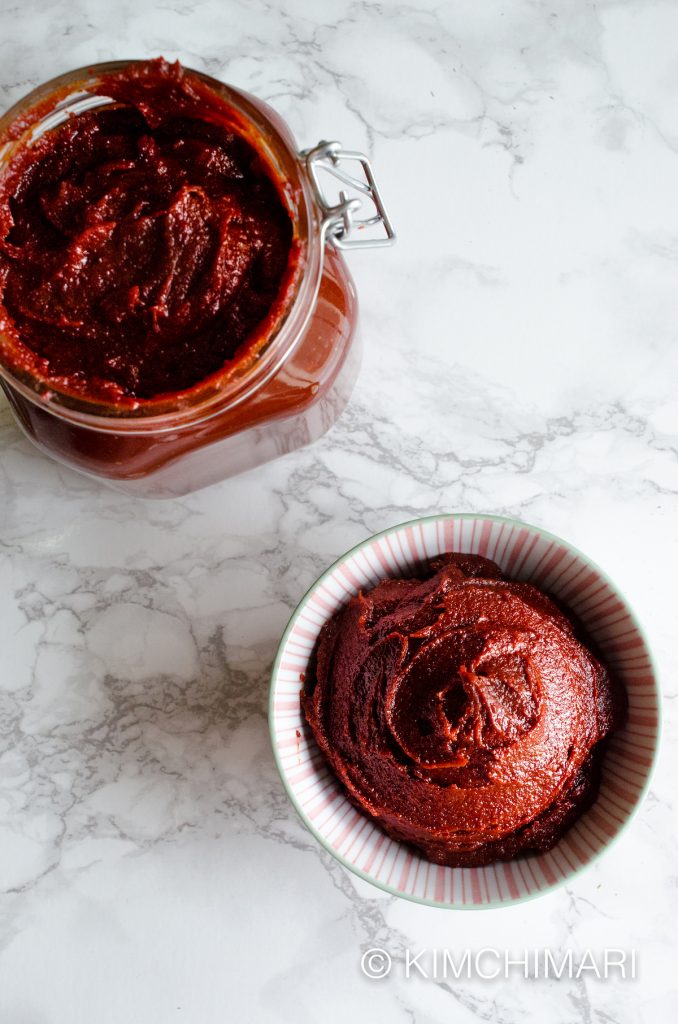
Homemade gochujang recipe that allows you to have a ready-to-eat gochujang in just a couple hours! What? That’s almost instant in the Korean fermentation world!! Is that possible?? Is it any good? You may ask… And my answer is YES and Yes, I mean, it’s pretty good considering it is ready in just few hours vs months.
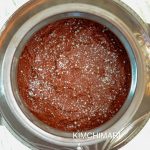
BTW, if you want to go all the way and make it the slow, traditional way using yeotgireum, try my very popular traditional gochujang recipe.
So I have to say I was pretty skeptical when I first learned this easy and quick homemade gochujang recipe from a temple food instructor Ms. Han a few years back while in Korea. I first met her while attending a temple food (sachal eumsik 사찰음식) class. Afterwards we kind of became friends… During class, she shared on how temple food helped her regain her health after having suffered with various health issues for so many years. Several years before, she said she was an art student in Italy and because she was so busy with her studies, she did not even have time to grocery shop properly let alone cooking for herself. So she said she ate just canned and instant foods all the time. Little by little, her health started to deteriorate with skin issues and other stomach issues. Things got so bad that she had to give up her studies and come back home to Korea. After coming back to Korea, she tried everything to cure her illnesses but nothing really helped until she decided to totally change her diet and went fully into temple food. She said after 6 months or so of cooking and eating temple food, her health slowly got back to normal and now, although she still has sensitive skin, she told us that she has no other health issues. So, naturally, she became a fan of temple food!
In 2014, when I opened my cooking studio in Seoul, she shared this easy and quick ready-to-eat gochujang recipe as a gift to me. And I was recently reminded of this recipe while I was making my gochujang for this year. I know this instant homemade gochujang recipe will never have the complex flavors that my authentic gochujang recipe (also on my blog) will develop over time but I know that this easy homemade gochujang recipe is still much better than the store bought ones – both in terms of flavor and health (no corn syrup and very little gluten).
The main difference between the two recipes is the milled malt barley. This quick and easy homemade gochujang recipe does not use any milled malt barley but just uses Korean rice syrup (jocheong 조청). But jocheong is made from rice and milled malt barley (yeotgireum 엿기름) so in some ways we are not going too far off the original recipe.
BTW, when I say ‘quick’, I mean quicker than my original recipe. 2 days + months of fermentation VS 2 hrs + few days of fermentation (optionally).
So here’s how you can make your own –
EASY HOMEMADE GOCHUJANG RECIPE
Makes: 4 cups Total Time: 2:40 hrs (Active: 40 min) Difficulty: Easy
Ingredients (** you can buy all the needed ingredients from my store – see Fermentation category)
- 2 C Korean gochukaru for gochujang (fine chili powder for gochujang) 고운고추가루
- 1.5 C meju powder (fermented soybean powder)
- 1/2 C sweet rice flour
- 1/2 C sea salt
- 1 C rice syrup (jocheong)
- 3.5 C water
- 1 Tbs green plum syrup (maesil cheong) – optional
- soju or sake – optionally if too thick
- In a pot (preferable flat bottomed and uniform sides), mix water and sweet rice flour. Mix it well with a whisk. Bring to boil, stirring often to prevent any lumps from forming and to make a paste. (much like sweet rice paste for kimchi)
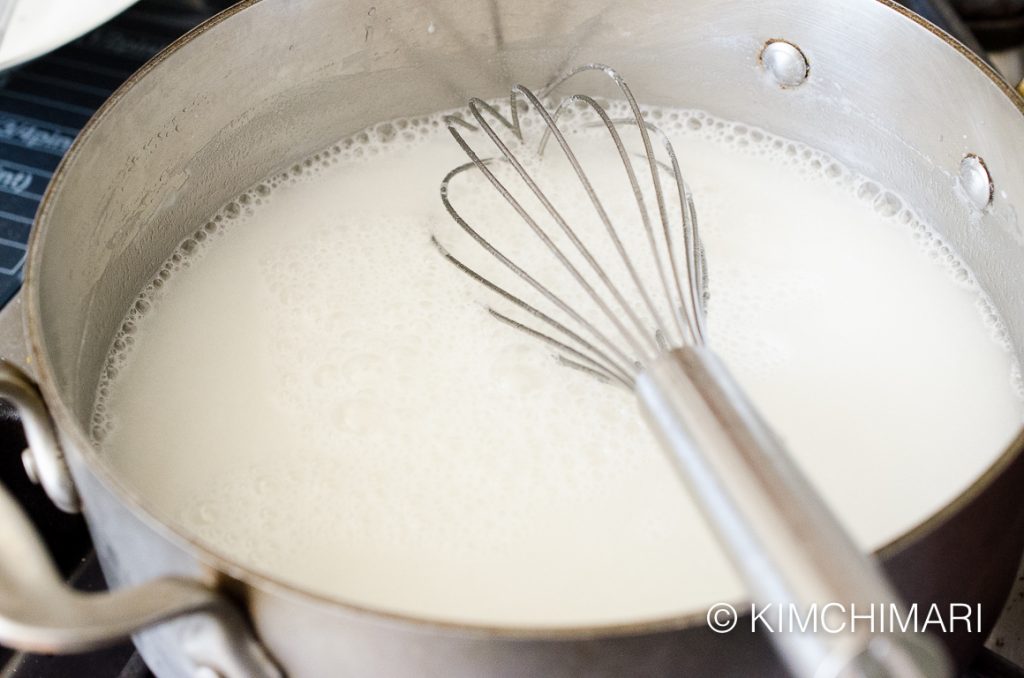
sweet flour and water in pot for gochujang - When it starts to boil, reduce heat and simmer for 10 min. or so until it is fully thickened to a paste. Stirring often to avoid lumps.
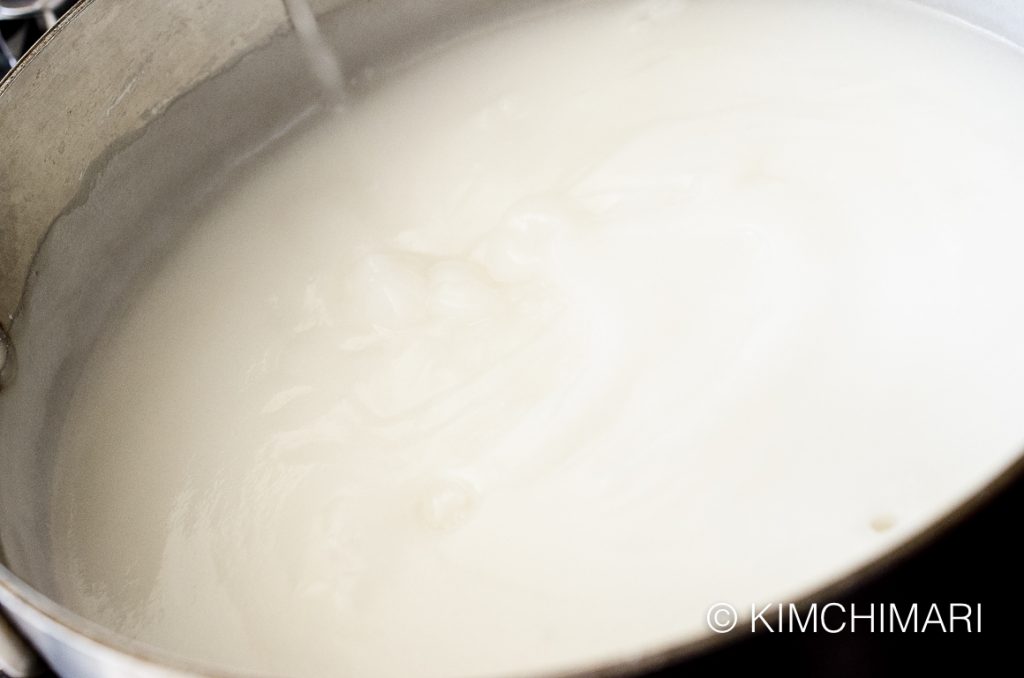
sweet flour paste for gochujang - Add 1 cup rice syrup to sweet rice flour paste and mix. You can add more if you want a sweeter gochujang.
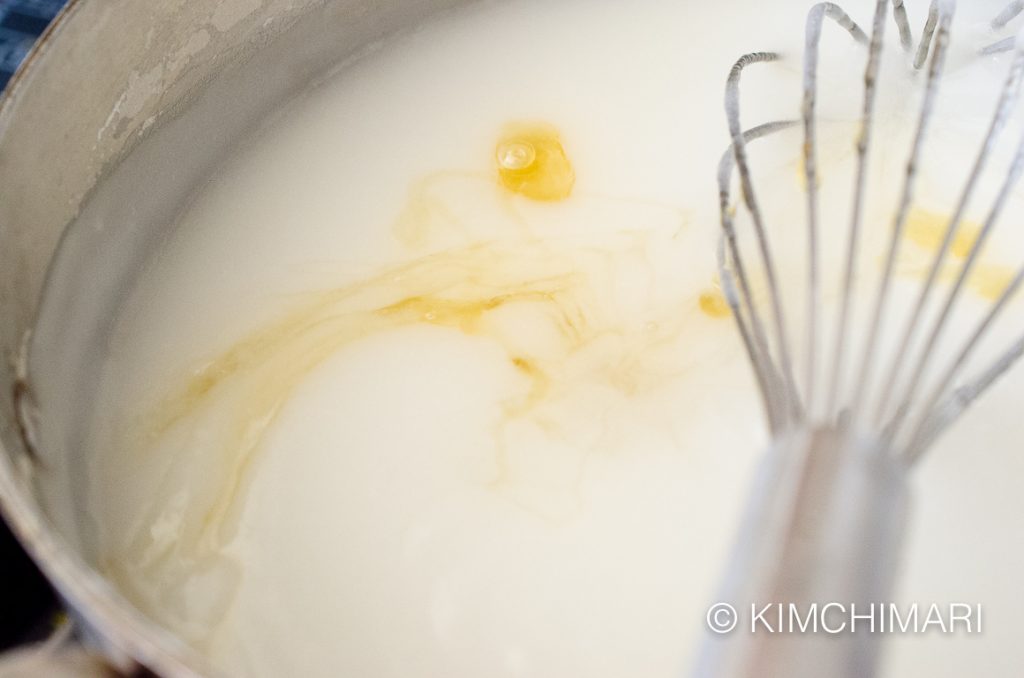
rice syrup in sweet rice paste Once you mix the syrup, the paste will become watery, no longer thick. That’s fine. Just continue to simmer for another 20-25 minutes until the volume reduces about 20%. Tip – you can measure the 20% reduction of liquid by using a chopstick to measure the height of the pot at the beginning and throughout. So if the height was 10 cm to start, you can stop when it is 8 cm. Note this will work only if you have a pot that is uniform in shape i.e. the diameter of the bottom and top of the pot is the same.
- Turn off heat and let it cool.
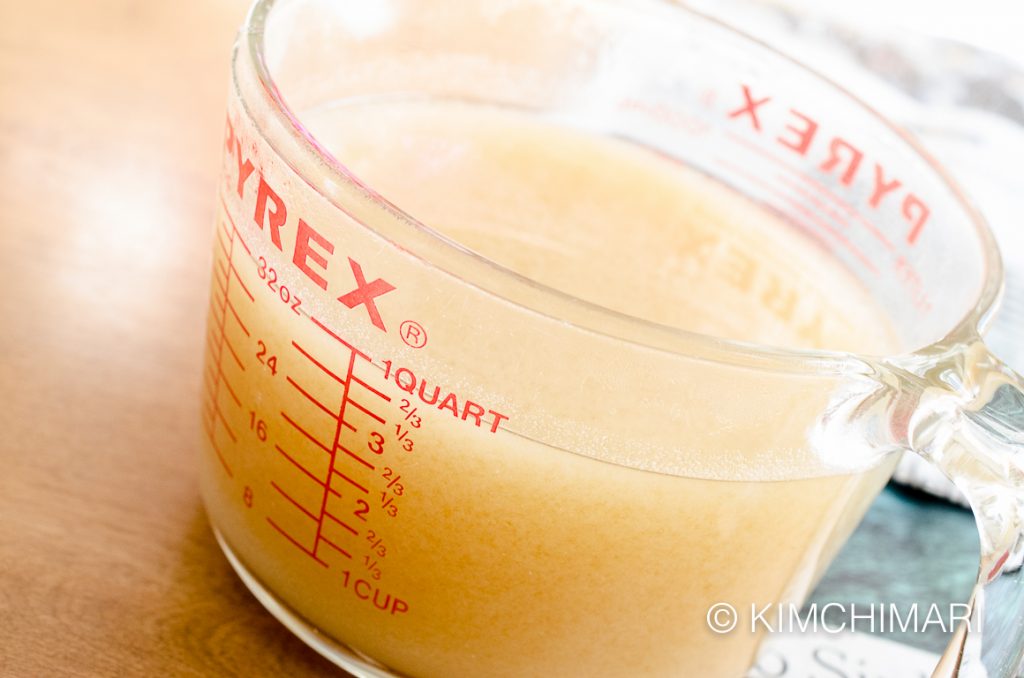
rice syrup sweet flour liquid for gochujang recipe Cooling time will be different based on your room temperature but for me it took about 2 hrs to cool the rice paste + rice syrup mixture from 3. It doesn’t have to be cold, just room temp. I transferred it to this glass measuring cup to cool it more quickly. You can always cool it in the fridge or in an ice bath to shorten the cooling time.
- Add meju powder, chili powder and salt to cooled rice syrup liquid.
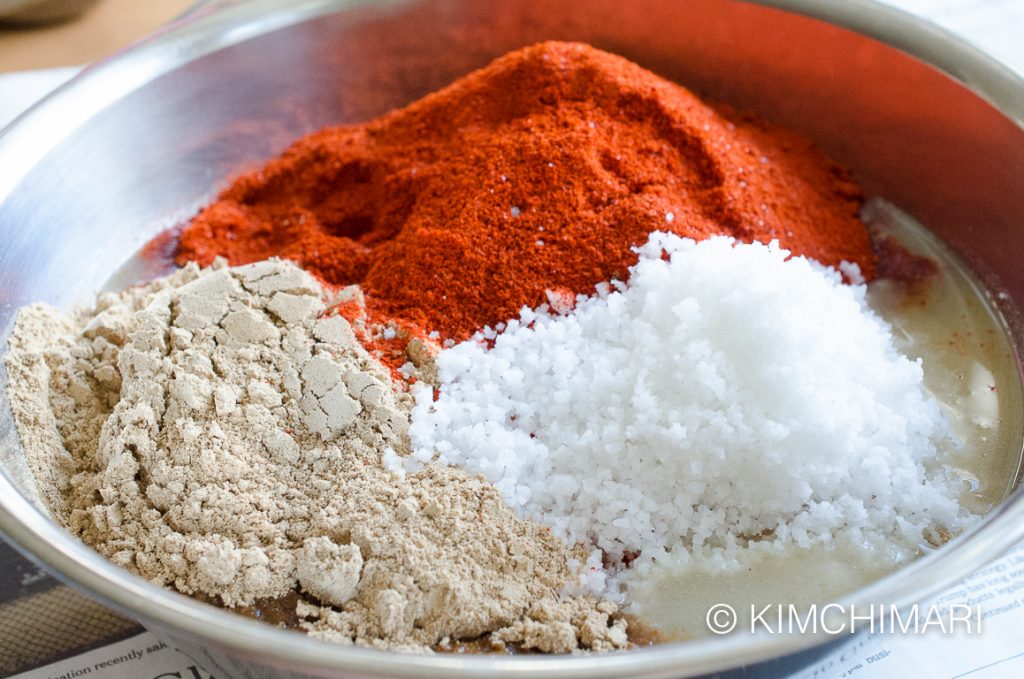
meju chili powder salt for gochujang - Use a whisk and mix everything well until there are almost no lumps.
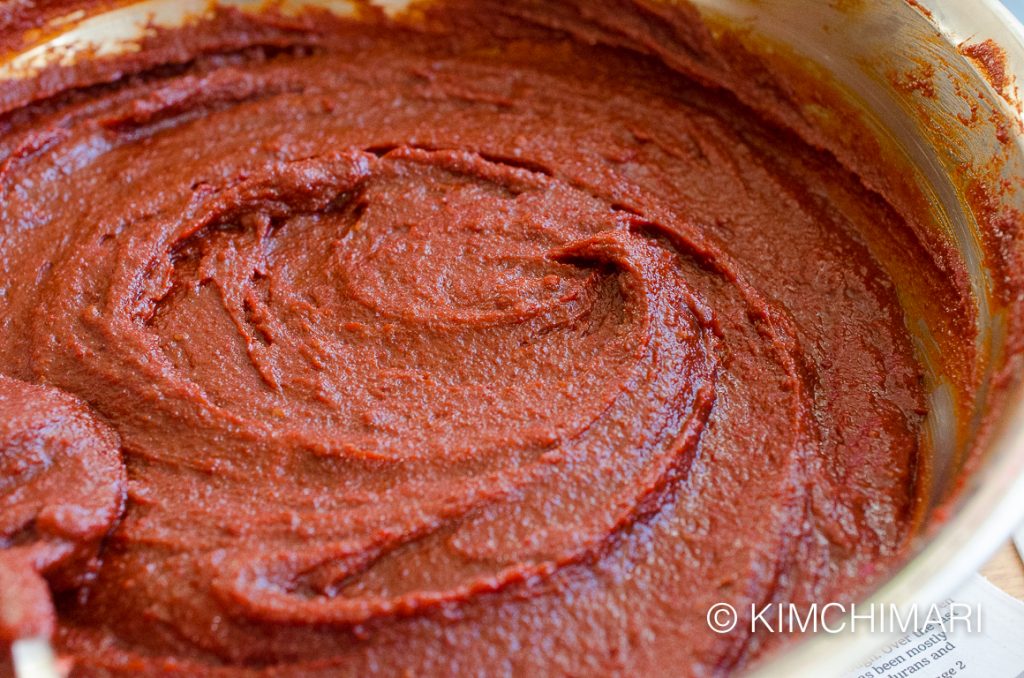
easy gochujang recipe mix - And there you go! You now have instant gochujang that you can use right away!!
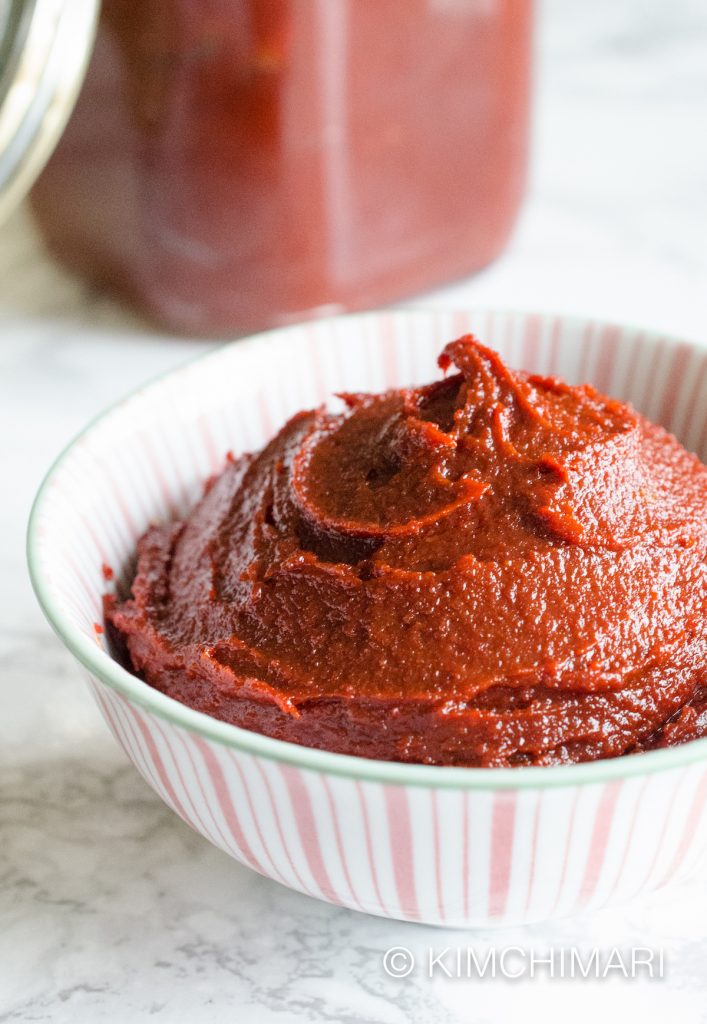
Easy Homemade Gochujang Recipe
Easy Homemade Gochujang Recipe That’s Almost Instant!
Ingredients
- 2 C Korean gochukaru for gochujang (fine chili powder 고추가루 for gochujang)
- 1.5 C meju powder (fermented soybean powder)
- 1/2 C sweet rice flour
- 1/2 C Sea Salt (Trader Joe's)
- 1 C rice syrup (jocheong)
- 3.5 C water
- 1 Tbsp green plum syrup (maesil cheong) – optional
Instructions
- In a pot (preferable flat bottomed and uniform sides), mix water and sweet rice flour. Mix it well with a whisk. Bring to boil, stirring often to prevent any lumps from forming and to make a paste. (much like sweet rice paste for kimchi)
- When it starts to boil, reduce heat and simmer for 10 min. or so until it is fully thickened to a paste. Stirring often to avoid lumps.
- Add 1 cup rice syrup to sweet rice flour paste and mix. You can add more if you want a sweeter gochujang.
- Turn off heat and let it cool.Cooling time will be different based on your room temperature but for me it took about 2 hrs to cool the rice paste + rice syrup mixture from 3.
- Add meju powder, chili powder and salt to cooled rice syrup liquid.
- Add meju powder, chili powder and salt to cooled rice syrup liquid.
- Use a whisk and mix everything well until there are almost no lumps.
- Let your gochujang mature a little more for 2-3 days in the fridge or at cool temperature before using it for even more flavor.
Tips & Notes:
- This is NOT the traditional gochujang recipe where it's meant to ferment for months outside in the sun. This is meant to be consumed pretty quickly and will not change much in flavor over time and may not last very long (i.e. will not have the deep ripened flavor)
- Buy special fine chili powder that is made specifically for gochujang (고추장용) or grind it very fine, like ground black pepper.
- It is important that the rice paste is cooled (not cold but room temp). If you add meju powder to hot liquid, the smell of meju powder will be too strong.
- If gochujang mixture seems to be too thick, you can add 1-3 Tbs of sake or soju. Mine came out a little on the thick side - I like mine that way.
- If you have maesil cheong (green plum syrup), you can add 1-2 Tbs for added flavor and sweetness. Now, you have Maesil flavored Gochujang. You can make your own maesil cheong or buy it. Substitute corn syrup or Oligodang syrup instead if you can't get maesil syrup.
Nutrition Information:
Notes
- This is NOT the traditional gochujang where it’s meant to ferment for months outside in the sun. This is meant to be consumed quickly.
- Buy special fine chili powder that is made specifically for gochujang (고추장용) or grind it very fine, like ground black pepper.
- It is important that the rice paste is cooled (not cold but room temp). If you add meju powder to hot liquid, the smell of meju powder will be too strong.
- If gochujang mixture seems to be too thick, you can add 1-3 Tbs of sake or soju. Mine came out a little on the thick side – I like mine that way.
- If you have maesil cheong (green plum syrup), you can add 1-2 Tbs for added flavor and sweetness. Now, you have Maesil flavored Gochujang. You can make your own maesil cheong or buy it.
Well, I hope you enjoy this easy gochujang recipe!
XOXO,
JinJoo
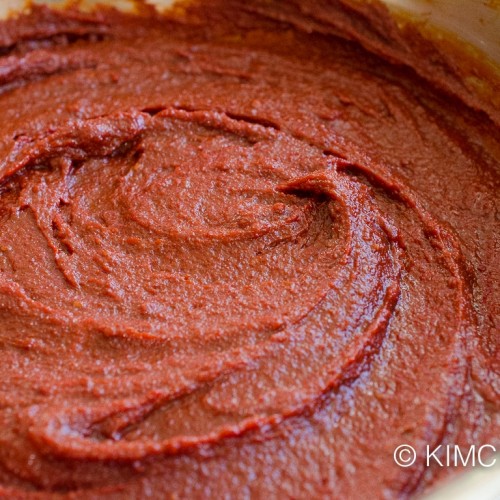
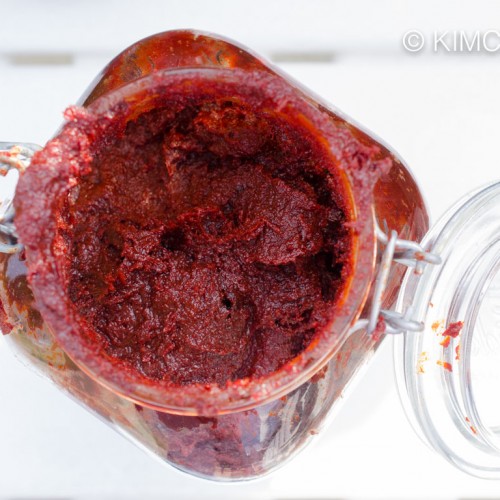
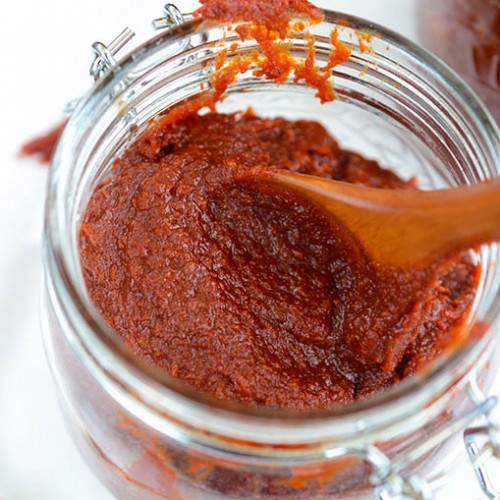

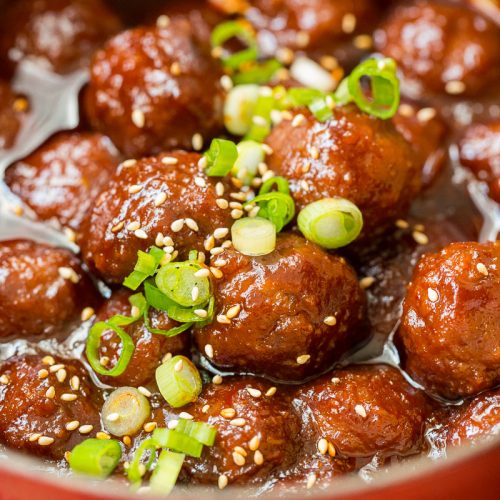
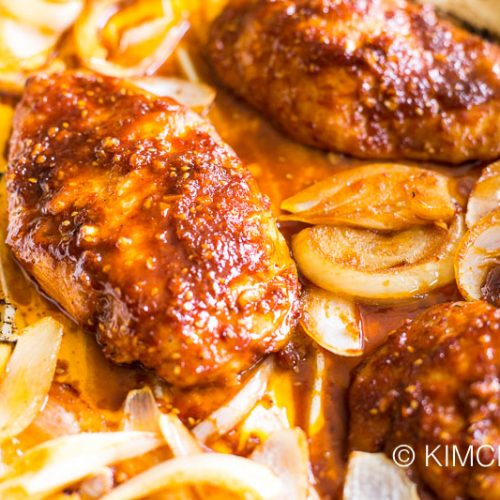
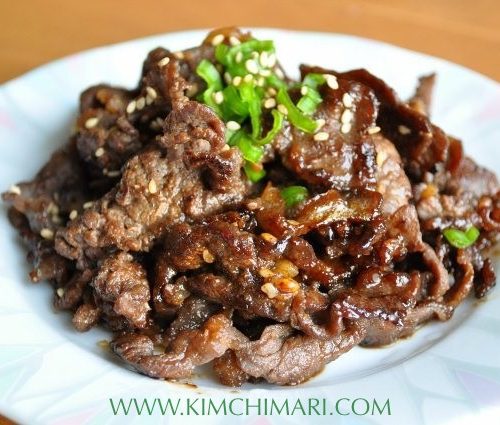
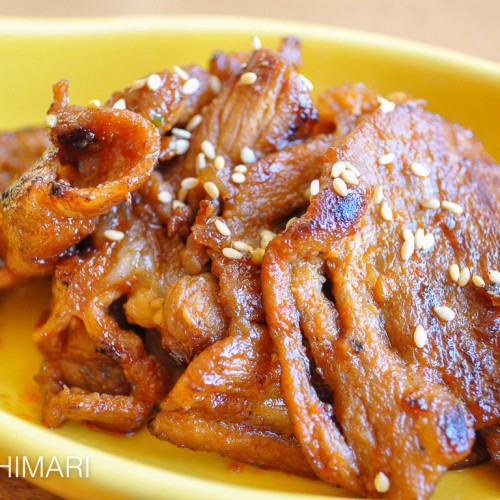
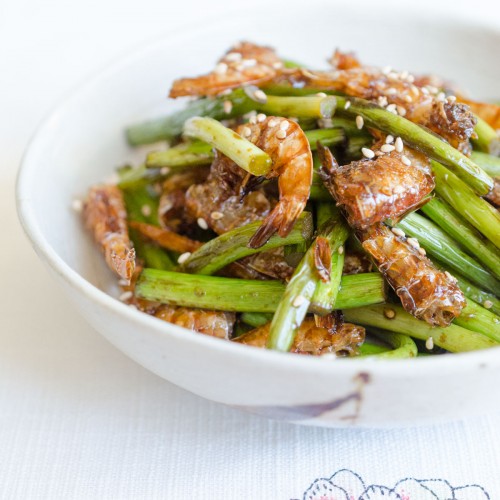
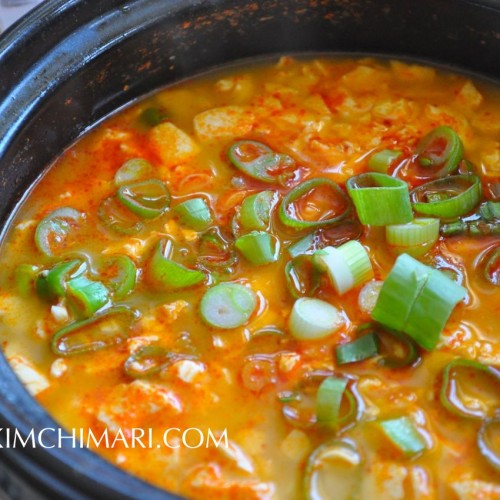
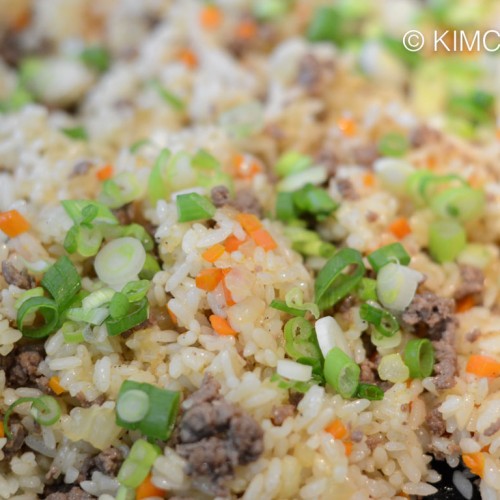
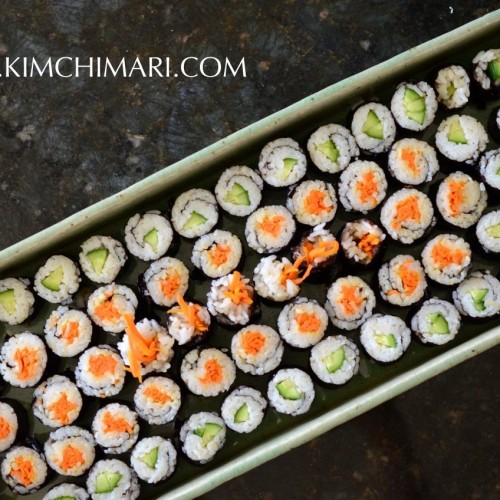
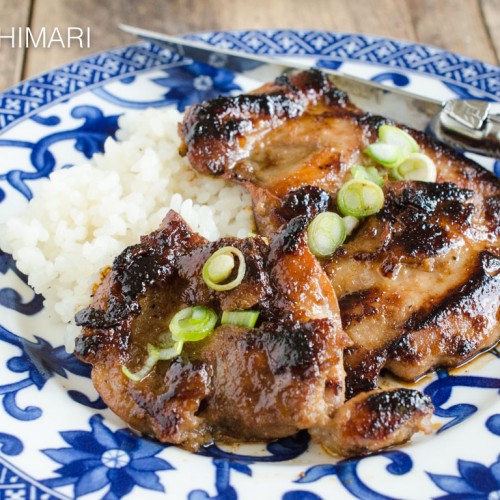
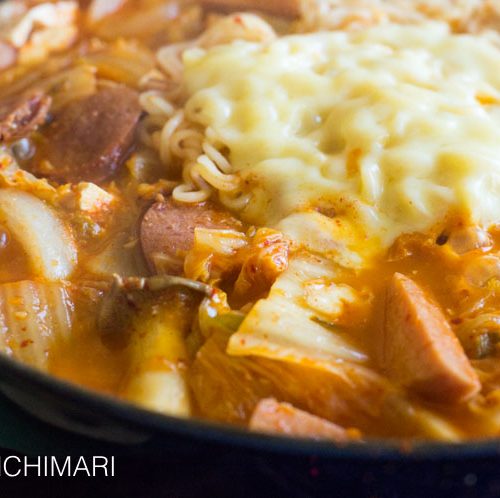
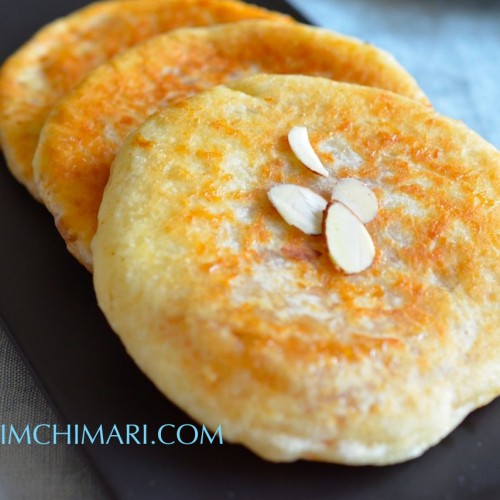






Hi JinJoo,
I was so pleased to come across your recipe for gochujang( both versions actually ). I have loved using gochujang ( Hot Pepper paste ) for years but recently I had a heart attack and needed to change to a low sodium diet. so i’ve adapted to my diet change by preparing foods myself. I am hoping your recipes will do the trick. I am starting with the instant version first. ( Currently the rice mixture is cooling down. So I can’t tell you how it turned out just yet.My only change is cutting back on the sodium. I am hoping it still works as well as it should. I do have a question related to the long version of gochujang. I was wondering if you heard of an indoor version of fermentation, possibly using sunlamps or something like that. This way I have much more control over conditions which I don’t if I try to ferment it outside. Let me know if you heard of an indoor fermentation alternative. I’ll also let you know how the low sodium version turns out.
Many Thanks
Hello Curtis, soo the reduction of salt and the lack of direct sunlight (UV) (if you decide to ferment indoors) may allow mold to grow easily on top. One way to discourage that is to ferment it in the fridge if you can. It will just ferment really slow – probably 2-3 times longer. Also, the sprinkling of the salt on top will prevent molds so try reducing the overall salt amount but making sure to sprinkle some salt on top after you put it in the container. One tip I found on the Korean internet which I haven’t tried is to layer 2-3 pieces of gim (korean dried seaweed nori – untoasted or seasoned) on top and then sprinkling a good amount of salt on top of the gim to just totally stop the mold. So this would possibly work (I haven’t tried it but would love to hear back if you try it) indoors since all that would eliminate the sunlight anyway. Hope this helps. Good luck!!
Hi JinJoo,
Since the Plum Syrup in the recipe is “optional,” to what degree does its omission change the taste/outcome?
For example, it’s my understanding (which may be entirely wrong) that Plum syrup neutralizes other strong tastes like the fermented soybean. Anyway, our goal is to limit sugar as much as possible…
The plum syrup adds just a little more smooth and sweet flavor. Omitting it will not change much. If you want you can reduce the rice syrup a little too. Just by making my recipe, you are reducing the sugar a whole lot as you know store bought gochujang’s main #1 ingredient is corn syrup.
Thank you for the recipe. Would it turn out okay using soybean powder instead of meju (fermented soybean powder)?
Hi Sun. A regular soybean powder is totally different from Fermented Meju soybean powder. I am afraid you will get a totally different kind of paste if you don’t use the meju powder. The meju powder has a special deep fermented flavor which will be missing, not to mention the fact that it will not be fermenting at all. Sorry that my answer is not positive. Thanks for asking!
Hi Jin Joo. I have never made gochujang in my life. I will try to make your easy version. Do you know why I should use rice syrup instead of corn syrup?
HI Sang, thanks for asking. There are several reasons – one is that rice syrup is the traditional ingredient that was always used in making gochujang which gives you better flavor and allows for better fermentation. And as you may know, corn syrup is not very good for your health whereas rice syrup is more naturally made. Hope that helps. Thank you.
Hi JinJoo, I was wondering if it would be ok to substitute the rice syrup with honey? Thanks!
Hi Rose, while I have not ever made gochujang with honey or have seen anyone using it instead of rice syrup, I think it would be possible. But because honey has natural anti-bacterial properties (due to the density), I would recommend that you use raw honey and also dilute it with water before adding it. Which then will probably make it more water than rice syrup. If that’s the case, you should reduce the malt barley + sweet rice mixture a bit more than 20%. Hope it works for you! Please let me know how it turns out because I’m really curious to know. Thanks for asking.